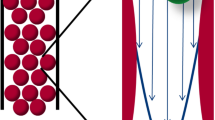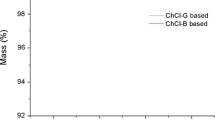Summary
In Inverse Size (or Steric) Exclusion Chromatography (ISEC) measurements, the investigated material is used as a stationary phase in a chromatographic column and the elution volumes of a series of standard solutes with different molecular size are measured. By an appropriate choice of mobile phase and type of standard solutes, specific (enthalpic) interactions between investigated material and solutes are eliminated so that the elution volumes depend on the porous structure of the column filling only. Then, a mathematical treatment of elution data can provide detailed information on both the macropores and the microporous structure of e.g. a swollen polymer gel in a polymer that is grafted onto silica. The basic principle of the evaluation of porosimetric information from chromatographic data is the assumption that the real porous structure of an investigated sample can be modelled as a collection of discrete pore fractions, each containing pores of different but uniform size and of simple geometrical shape. Problem then is to determine the combination of volumes of these fractions which yields the best agreement between computed and experimental values of the elution volumes of standard solutes. It is possible to perform the ISEC measurements either in an organic solvent or “non-solvent” (e.g. tetrahydrofuran or methanol) or in water, depending on the compatibility of the investigated material with the respective environment. For non-polar polymers, like copolymers of styrene and divinylbenzene, the use of tetrahydrofuran as the mobile phase with alkanes and polystyrenes as standard solutes has been recommended. Alternative ISEC investigation of the same material in an organic and an aqueous environment can provide additional information on its lipo- or hydrophilicity. This method has provided specific information, not obtainable by mercury porosimetry, when modifying silica by a coupling agent, polymerizing different monomers to different extents.
Similar content being viewed by others
References
K. K. Unger, “Porous Silica”, Elsevier, 1979.
E. Carlier, A. Guyot, A. Revillon, React. Polym.16, 115 (1991/2).
I. Halasz, P. Vogtel, Angew. Chem. Int. Ed. Engl.,19, 24 (1980).
D. H. Freeman, S. B. Schram, Anal. Chem.53, 1235 (1981).
K. Jerabek, Anal. Chem.57, 1595 (1985).
A. G. Ogston, Trans. Far. Soc.,54, 1754 (1958).
H. Kamogawa, A. Kanzawa, M. Kadoya, T. Natto, M. Nanasawa, Bull. Chem. Soc. Jap.,56, 762 (1983).
J. H. Knox, H. Ritchie, J. Chromatog.387, 65 (1987).
W. P. N. Fernando, C. F. Poole, J. Planar Chromatogr.5, 50 (1992).
K. Jerabek, Anal. Chem.57, 1598 (1985).
K. Jerabek, K. Setinek, J. Polym. Sci.; Part A: Polym. Chem.28, 1387 (1990).
Author information
Authors and Affiliations
Rights and permissions
About this article
Cite this article
Jerabek, K., Revillon, A. & Puccilli, E. Pore structure characterization of organic-inorganic materials by inverse size exclusion chromatography. Chromatographia 36, 259–262 (1993). https://doi.org/10.1007/BF02263874
Received:
Revised:
Accepted:
Issue Date:
DOI: https://doi.org/10.1007/BF02263874




